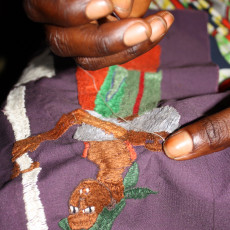The complexity of the SOS FED quilt project required extensive planning taking place over several weeks. After determining that approximately 100 women wanted to take part in this innovative therapeutic program, SOS FED staff and I quickly realized that we would be faced with the challenges of producing a quilt of quite an impressive size (approximately 9 feet x 7 feet). Many logistical matters were put in place for the project to run smoothly.
Naming the project was first on the agenda. While the quilt will ideally convey the plight faced by women in the Eastern Congo in regards to rampant sexual violence, we do not want to dwell on the difficulties posed by these circumstances. True, the situation for these women has been bleak, but they are optimistic and we wanted this project to reflect their optimism in the face of a daunting situation. The project is to be named Ahadi, Swahili for “promise.” The name refers to the promise of continuous support to struggling survivors by SOS FED as well as the promise that better days are ahead when women work together.
As mentioned in a previous post, Ahadi will take the form of a narrative quilt. SOS FED and AP workers chose eight themes to tell the beneficiaries’ stories, each theme representing moments in the lives of rural Congolese women. The themes are: (1) War, (2) Sexual violence, (3) The position of women in Congolese society, (4) Services given by SOS FED, (5) The importance of education and psychological therapy, (6) Financial independence, (7) Denunciation of sexual violence, and (8) Recovery and the continued difficulties faced by survivors of sexual violence. Each participant will produce an image conforming to a theme of their choosing. Given the size of the project, we thought it best to provide thematic guidelines both to achieve a cohesive result and to encourage a discussion about what it really means to be a survivor of rape in the Congo.
Ahadi, the final product, should be a moving piece of art that also acts as an effective advocacy tool—who better to narrate the experiences of Congolese women than the women themselves?
Posted By 2010 Fellow
Posted Sep 7th, 2010

